A perspective by Shri Dharambir Singh, MBE and Dr Gurinder H. Singh
Abstract: This essay seeks to explore the relationship through the mediator of Nature, the natural space within which music exists. I refer here to the musica universalis, the music of the heavens, where even the movement of the celestial bodies like the stars and the planets produce their own music. This music was thought to be embedded within the consciousness of all beings, that this was the tune to which we were born. I would like to point out here that the circadian rhythms, which form such an important part of the contemporary wellness discourse, are an extension of this universal rhythm.
The very basis of creation is vibration. It is a well-known fact that almost all the wisdom traditions of the world and modern sciences agree on this. The creator is referred to as Ōm, Nād Brahmā, Ek Omkar, Shabad, Parā Vāk, Anhad Naad, Shrūti Gandharva gaan, etc in the Indian traditions and Logos, Primordial Word, Bangē Āsmāni, Shrosta etc in many other traditions. Wherever there is vibration there is sound and light. So it can be said that the basis of all that exists are the two principles of Sound and Light. In the Indian classical ragas, the relationship between sound and light is mediated through the seasons – Ritus. As the Sun travels through the sky, and seasons shift, so do the ragas. As the ragas themselves pay homage to the Gods, there is a clear parallel relationship between the musical, the rhythmic and the divine. So the 12 months(1) and 6 seasons are represented in music as well.
(1)Basant Ritu- Spring, Grishma Ritu- Summer, Varsha Ritu-Monsoon, Sharad Ritu- Autumn, Hemant Ritu- Pre Winter, Shishir Ritu- Winter
As Music is the science of sound, naad, in the form of Pitch, Timbre, expanse and Rhythm, it becomes an important thread connecting to the creator -Naad Brahama. Many mystics including Shabas Tabrez, Maulana Rum, Kabir, Guru Nanak have chosen this path to realise their true nature. For them, music was the path to the divine, as it provided a way to explore and celebrate divinity. Guru Granth Sahib especially locates the divine within the rhythms and transitions of nature. Some examples are given here.
Spring
Aaj hamare grahe Basant I
Gun gaaye Prabh tum basant II (Raga Basant: 5th Guru Arjan Dev. GGS Ang:1180)
***
And soon after Basant falgun is just at my door step
Aaj hamare banne Faag I
Prabh sangi mil khelan lag II
Holi keene sant sev I
Rang laga ati lal Dev II (5th Guru Arjan Dev. GGS Ang:1180)
***
Falgun Anand Upaar Janaa, Har Sajan pragate aaye I
Sant Sahaae Ram ke , Kar Kirpa leho milaye II (5th Guru Arjan Dev. GGS Ang 133)
***
Summer
Har Jaith juranda loriae, Tis agge sab nivan II
***
Asaad tapanda tiss lagge, Har Naau na jinna paas II (5th Guru Arjan Dev. GGS Ang 133)
***
Monsoon
Saawan Sarsi Kaamni I
Charan Kamal siyon pyaar II
Man tan ratta sach rang I
Aeko Naam Adhaar II (5th Guru Arjan Dev. GGS Ang 134)
***
Bhadoe bharam bhulaneya I
………………………………………….II
The seasons have their own renditions, which are moulded according to the weather patterns. The pitch of the singers as well as the instruments changes through the day (nerves in the body are tender when one wakes up. Re Dha are the tender notes at dawn and move to shudh Re dha as the sun moves up) and as the sun transforms itself as the sun travels across the horizon. In the morning one sings and plays ragas of the dawn, in the evening, there is somnolence in music as well. (Evenings more like yearning and anxiety, restlessness) Therefore one has Tevra Madyam with the the tender Re Dha which reflects this tenderness.
The ragas are segregated in prahars through the day, with morning ragas being komal(notes or swaras) ragas – Lalit, Vibhaas and Bhairava are sung in the morning. Then as the morning progresses, one moves to the Todis and then the Bilaawals, which are the shuddha swaras. In the afternoons one finds the komal Nishaads, like the Sarangs and then the Komal Ga and Komal Ni like Bhimplasi, Patdeep. Early evening is for As one enters the twilight, there is again a change, from/with re-dha komal (Rishabh – Dhaivat komal) and with ‘Madhyam’ teevra. Dusk begins with Shree, then Puryia, then Marwah, then Puryiadhana shree, Puryia Kalyan, all these ragaas are of the dusk. For the first prahar of the night, after the sun has set, one encounters Yaman, Kedar, Bhoopali, Bihag, Kamod and Chaya nat, and even later into the depths of the night, there are Bhagyashree Bageshree, Malkauns and Chandrakauns and the Kanadas. This is by no means an exhaustive list, it is only to introduce to the reader the time-bound nature of the Indian music ragas. Music represents cyclical time, with specific raagas devoted to sunset and sunrise, with each treated as a different stage in time.
This is a reflection of the organic nature of music and the way in which natural principles and patterns repeat through various aspects of our life. It is not only the music but also the poetic content which follows these patterns. Unless one is practicing, doing one’s riyaaz, the ragas are not sung out of time although the norm is to practice the ragas at their assigned time, otherwise their peace is disturbed). The ragas are treated with a marked reverence, like sentient beings, which deserve the consideration due to fellow human beings. Moreover, there are internal quasi -familial relationships between the ragas. They have inter relations which reflect our societal formations, and thus they truly do represent life in all its complexity.
By correlating this with nature one endeavors to present a perspective on highlighting some key features and principles which govern some of the major aspects of Nature.
It is important to lay the foundation that everything is interconnected. Whatever is within is outside. It can be seen as a fractal design or a holograph. Fractals are infinitely complex patterns that are self-similar across different scales. To understand this let’s take an example of a Cauliflower, if it is broken into smaller pieces, each piece when seen under a lens or a microscope will be exactly the same shape as its larger part. This phenomena can be witnessed in many other designs of nature. In musical arrangements as well we see similar structures. So if we take up three notes, Sa-Re-Ga, those notes will be available for an infinite number of combinations. Each combination will reflect, invert, and replicate the original sequence. We have the structure of organic growth taking place through only three notes, and this can continue ad infinitum. This will become clear as we see some of the examples presented herewith.
The significance of numbers or mathematics is very important in nature. Pythagoras, the Greek philosopher asserted that in order to understand the Universe one has to understand Mathematics. It will be seen that the underlying fabric of Music is also maths. Numbers represent different aspects of creation, for example,
- Sa (primordial sound)
- Duality (Shiva Shakti)
- Trinity (Triad, Tihāyi in music)
5. Five elements
7. Colours of the Rainbow, Chakras and Musical Notes)
9. Astrology and Nine Swars of the ancient Indian music)
12. Months and Zodiac signs
These numbers are arranged in multiple patterns as have been mentioned below.
Doubling
1, 2, 4, 8, 16, 32, 64 etc
These can be seen in the cell formation. All beings start off from one cell, doubling each instant thus forming the structures which make up the body.

Fibonacci Series
1,1,2,3,5,8,13,21,34,55,etc
Fibonacci principle is the idea of each number being added to the previous number thus generating a string of numbers as above. If we look at the structure of a Sunflower, a Tree or a Shell, the Fibonacci series is evident in the structure.
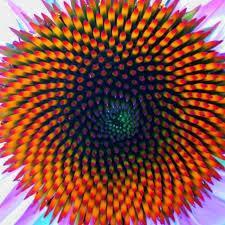
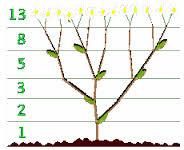
Harmonic Series
1,2,3,4,5,6,7,8,9,etc
Every vibrating body divides itself naturally at different points to give out different pitches all related to each other as overtones or harmonics. It is these harmonics which due to their unique intensity make up the unique signature of every sound. This is the very quality by which we can distinguish between different human voices, musical instruments etc. Representing the following musical notes Sa, Tār Sa, Pa, Sa,Ga,Pa and Ni, these harmonics keep on being created even beyond our hearing threshold.
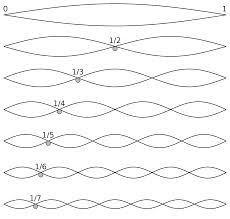
Rhythmic Jatis
1 (Matra)
3 (Tisra)
4 (Chatusra)
5 (Khanda) (2+3)
7 (Misra) (3+4)
9 (Sankeeran) (2+3+4
These Jatis or groupings form the very basis of the Indian Rhythms. All the Tāls fit into one of the above Jātis. Again the same numbers keep coming up in the design, musical pitch and the rhythm.
Mirroring
This is evident in many of the Paltas played and sung by the musicians. The Merkhand permutations are also another example of this idea in music.
12 -21 (SaRe – ReSa)
123-321 (SaReGa – GaReSa)
1234-4321 (SaReGaMa – MaGaReSa)
12123-32321 (SaSaReGa – GaReGaReSa)
1231234-4324321 (SaReGaSaReGaMa – maGaReMaGaReSa)
Lines/Spirals
Sun, Moon, Earth
Lines – masculine
Spirals – feminine Shapes
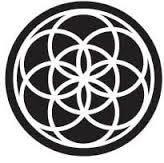
The movement of musical notes can be seen as different lines representing the above. The intonation of the notes in the Ragas represent Sun (vitality, energy, bravura etc), Moon (Tenderness, Compassion, Water, Fluidity) and Earth (heaviness, foundation, Mother etc). In the ancient system of Indian music Shadaj (Sa) and Rishab (R) have Raudra (Valiant) Bhāva, Gandhār and Nishād Karunā (compassionate) Bhāv and Dhaivat Vibhatsa (disgust) Bhāv. The Effect of Pancham (Pa) swar represents the Sun, Madyam the Moon and the Shudh Gandhār the Earth. It is the combination of the three entities of Sun, Moon and Earth that everything is formed. So is true in music as the three Swaras of Sa, Ga and Pa form the backbone of all the notes present in music.
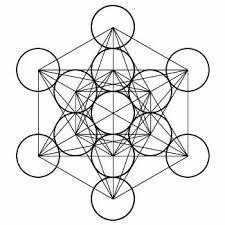
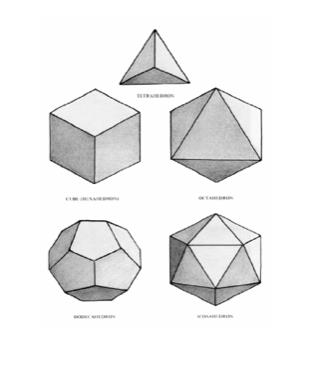
The various movements in music either straight lines (sapāt), Zig Zag (Vakra), Paltas (patterns) or Meends (spirals) bring about the masculine or the feminine qualities in music.
Five Elements – Akash (Either), Earth, Water, Fire and Air
These are seen to be the very basis of all the forms in nature. Each form, being unique in its makeup and the distribution of these five elements. The musical notes are seen as representation of the five elements. Rāgas as the manifestation, as a unique sound form almost similar to other forms.

Raga – Sound Mandala
“Mandala – is a spiritual and ritual symbol representing the Universe. The basic form of most mandalas is a square with four gates containing a circle with a center”
Digital Music
Computers, iPads and Mobile phones are now important tools of music making. It can be seen that everything in the digital domain is made up of 1 and 0 numbers, called the bits. Every sound produced in the Synthesisers and Samplers is translated into a strain of numbers. The communication between different devices and the Software’s is done via Midi, a unique language of numbers.
The patterns within music, which are also present in Nature are also part of healing. There are certain Ragas which work very well for healing, we have documented cases of migraine patients receiving relief from some ragas. Of course this varies widely, and since music itself is vast and diverse, we have a treasure trove of such natural resources for wellness. The uniqueness of the Indian Musical system is that from the very beginning of its inception it was always seen to be an extension of the creation or nature. Thus Music was seen to be an important tool and a path to realising the Oneness or Yoga (Union) of all. Non Duality realisation is the ultimate goal of all humanity. The final flowering or evolution is, becoming one with the primordial sound Om – Ek Omkār.
To conclude, I must reiterate that Music is the very soul of this world, and this is reflected in the various ragas and structures within classical music. Even the western system of music recognizes this in the work that has been done on the Gregorian Chat, and its role in the formation of Harmony. Music and its patterns form an essential network, almost like a bridge through which the performer as well as the audience can access the natural energies of nature. This is important for us to recognize, because increasingly, we have become oblivious to the role of these energies. Since one lives surrounded by Wifi, Bluetooth and other such networks, it has become easy to forget that these are also patterned on natural frequencies. The way a sound wave resonates and spreads is a natural pattern and these ‘modern’ patterns are designed through it. Even the modern concept of acoustics is an idea one encounters in classical music, with the way the instruments are created. The Veena – the placement of the swaras/notes was identified/assigned according to the vibrations( per second) of the string at different lengths on the veena the symbolic musical instrument of the revered Goddess Saraswati. The sitar, the table, tabla the harmonium, all instrumentalise air in different ways, and they function with distinct changes in different seasons, altitudes and atmospheric conditions. This is all based on a scientific enquiry, which emerges through a holistic engagement with science and music. To reconcile these two structures has been a struggle for our world, but in music, like in all natural phenomena, we see how these ideas are not only reconciled but also function as one. One are where there is a lot of ongoing work is therapeutic use of music. The meditative elements of music today are being used as therapy in the medical world. The different rasas are expressed in modulations of the notes and the notes are therapeutic for the self, whether it is a physical, emotional or even spiritual matter. There is thus a constant borrowing and symbiosis between man, music and nature. The physical and spiritual unite in the sound of music that binds us in the talas and time frames of daily life, the seasons and the body itself. There is thus a synchronicity and rhythm in music that is intrinsically entwined with the patterns and circle of life and its different expressions. In both the sacred spaces as well as the mundane, music represents the core that is deep and binding.
Suggested readings
Amarnath, P. 2020. The Dictionary of Hindustani Classical Music. India: Penguin Random House India Private Limited.
Shankar, R., Mahajan, A. 1989. Ragas in Indian Classical Music. India: Gian Publishing House.
Singha, V. P., Benegal, S. 2014. An Introduction to Hindustani Classical Music: A Guidebook for Beginners. India: Roli Books.
Hirlekar, H. 2010. Nuances of Hindustani Classical Music. India: Unicorn Book.
Joshi, G. N. 1977. Understanding Indian Classical Music. India: Taraporevala.
Rothenberg, D. 2013. The Book of Music and Nature: An Anthology of Sounds, Words, Thoughts. United States: Wesleyan University Press.
Stromeyer, C. E. 2018. Unity in Nature: An Analogy Between, Music and Life (Classic Reprint). United States: Fb&c Limited.
Watson, K. B. 2018. The Nature and Measurement of Musical Meanings (Classic Reprint). United States: Fb&c Limited.

